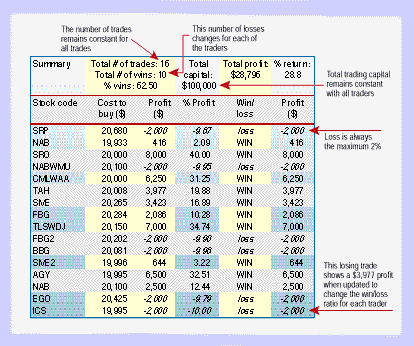MONEY MANAGEMENT
Trader's Progress
Better Trading with Risk Control
by Daryl Guppy
How do you improve your trading results? Risk management, of course.
Understanding how the tools of technical
analysis work and how they are applied makes a big difference to your initial
trading results. A novice trader will see his or her trading improve quickly
at first, but then it all seems to bog down. This becomes even more pronounced
when markets become skittery or take on a bearish slant. Despite this performance
decline, of course everyone wants to aim for a 90% success rate. Is this
achieved through reading, coursework, and better trading programs? Or is
there a simpler way?
THE ANALYSIS
To study this question, I looked at 16 sample trades (shown in Figure
1). I didn't use random results; these are real trades, real losses,
and real returns taken from my own records. The series of sample trades
has six common features:
1. Total trading capital is always $100,000; this allows for
a consistent risk calculation.
2. Profits for winning trades remain as shown on the base trade.
3. No profits are added to trading capital. They are swept into a holding
account and not used for trading.
4. Only realized gains are counted. These come from closed trades.
5. The risk level is always a constant percentage of the total trading
capital, so 2% risk equals $2,000, and 10% risk equals $10,000.
6. Losing trades always lose the full amount of risk.
This analysis allowed me to explore the effects of two variables. The
first variable is the win/loss ratio, and the second is the level of risk
in each trade.

Figure 1: Sample trades. Here you see the effect of changes in
the win/loss ratio.
...Continued in the September 2002 issue of Technical Analysis of STOCKS
& COMMODITIES
Excerpted from an article originally published in the September 2002
issue of Technical Analysis of STOCKS & COMMODITIES magazine. All rights
reserved. © Copyright 2002, Technical Analysis, Inc.
